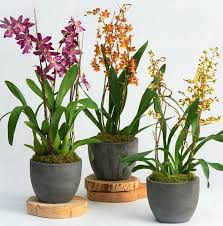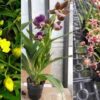# Exploring Pollinators of Oncidium Orchids: Bees and Butterflies

Oncidium orchids, commonly referred to as “Dancing Lady Orchids,” are cherished for their vibrant colors, intricate shapes, and captivating beauty. However, the allure of these orchids extends beyond their aesthetic appeal; they play a crucial role in the ecosystem as a source of nectar and habitat for various pollinators. This article will delve into the fascinating world of the bees and butterflies that pollinate Oncidium orchids, examining their behaviors, ecological significance, and the intricate relationships they form with these beautiful plants.
## 1. Understanding Oncidium Orchids
### 1.1 General Characteristics
Oncidium orchids belong to the Orchidaceae family and are known for their distinctive flower shapes and colors. The most common characteristics include:
– **Diversity**: Oncidium encompasses a wide variety of species and hybrids, resulting in numerous flower shapes, colors, and sizes.
– **Growth Habit**: These orchids can be epiphytic, growing on other plants, or terrestrial, growing in soil. Their adaptability allows them to thrive in various environments, from tropical rainforests to subtropical regions.
### 1.2 Importance of Pollination
Pollination is a vital process for the reproduction of flowering plants, including Oncidium orchids. Successful pollination leads to the production of seeds, ensuring the continuation of the species. Oncidium orchids have evolved specific traits to attract their pollinators, including:
– **Nectar Rewards**: The nectar produced by Oncidium orchids serves as a food source for pollinators, incentivizing them to visit the flowers.
– **Color and Scent**: The bright colors and fragrances of Oncidium flowers are designed to attract specific pollinators, enhancing the likelihood of successful pollination.
## 2. The Role of Bees in Pollinating Oncidium Orchids
### 2.1 Types of Bees
Bees are among the most effective pollinators of Oncidium orchids. There are several species of bees that visit these flowers, including:
– **Honey Bees (Apis mellifera)**: Known for their social behavior and ability to communicate with other bees, honey bees are highly efficient at pollination. They are attracted to the nectar and bright colors of Oncidium orchids.
– **Bumblebees (Bombus spp.)**: These larger bees are excellent pollinators, particularly in cooler climates. Their ability to buzz-pollinate allows them to release pollen from the flowers effectively.
– **Solitary Bees**: Many solitary bee species also contribute to the pollination of Oncidium orchids. These bees, such as mason bees and leafcutter bees, often prefer specific flower types and can enhance the genetic diversity of orchid populations.
### 2.2 Pollination Process
The pollination process involving bees typically follows these steps:
1. **Attraction**: The bright colors and enticing scents of Oncidium flowers attract bees, drawing them in for a visit.
2. **Nectar Collection**: Upon landing, bees collect nectar from the flower, which serves as their primary food source. While doing so, they come into contact with the flower’s reproductive structures.
3. **Pollen Transfer**: As bees move from flower to flower, they inadvertently transfer pollen from the anthers of one flower to the stigma of another. This transfer facilitates fertilization and seed production.
### 2.3 Benefits of Bee Pollination
The relationship between Oncidium orchids and bees is mutually beneficial:
– **Increased Reproductive Success**: Bee pollination significantly increases the chances of successful fertilization and seed production in Oncidium orchids.
– **Genetic Diversity**: By transferring pollen between different plants, bees contribute to the genetic diversity of orchid populations, which is essential for their long-term survival.
## 3. The Role of Butterflies in Pollinating Oncidium Orchids
### 3.1 Types of Butterflies
Butterflies also play a role in the pollination of Oncidium orchids, although they are less efficient than bees. Some common butterfly species that visit Oncidium flowers include:
– **Swallowtail Butterflies (Papilio spp.)**: Known for their vibrant colors and large size, swallowtail butterflies are attracted to the nectar of Oncidium orchids and can help with pollination.
– **Brush-footed Butterflies (Nymphalidae)**: This family includes a variety of species that may be attracted to Oncidium flowers for their nectar, contributing to the pollination process.
### 3.2 Pollination Process
The pollination process involving butterflies is somewhat different from that of bees:
1. **Attraction**: Butterflies are drawn to the bright colors and sweet scents of Oncidium flowers.
2. **Feeding**: They use their long proboscis to reach the nectar deep within the flower. As they feed, they may brush against the pollen.
3. **Pollen Transfer**: While butterflies are not as efficient as bees in transferring pollen, they can still contribute to the process, especially when multiple butterflies visit different flowers.
### 3.3 Benefits of Butterfly Pollination
While butterflies may not be as effective as bees in pollinating Oncidium orchids, their contributions are still valuable:
– **Supplemental Pollination**: Butterflies can provide supplemental pollination services, particularly in environments where bee populations may be low.
– **Ecosystem Interactions**: Butterflies are also essential components of ecosystems, helping to maintain balance and supporting the overall health of the environment.
## 4. The Importance of Habitat for Pollinators
### 4.1 Pollinator-Friendly Environments
Creating and maintaining a pollinator-friendly habitat is crucial for supporting the populations of bees and butterflies that pollinate Oncidium orchids. Key components of a pollinator-friendly environment include:
– **Diverse Plant Life**: Planting a variety of native flowering plants alongside Oncidium orchids can attract a wide range of pollinators. Native plants provide food sources and nesting sites, promoting healthy populations.
– **Minimal Pesticide Use**: Reducing or eliminating pesticide use in gardens and landscapes can help protect pollinators from harmful chemicals that can disrupt their populations.
### 4.2 Conserving Natural Habitats
Conservation efforts to protect natural habitats are essential for sustaining bee and butterfly populations:
– **Habitat Restoration**: Initiatives to restore degraded habitats can improve the availability of food and nesting sites for pollinators.
– **Education and Awareness**: Raising awareness about the importance of pollinators and their role in ecosystems can encourage more people to engage in conservation efforts.
## 5. Challenges Facing Pollinators
### 5.1 Habitat Loss
One of the most significant threats to pollinators is habitat loss due to urbanization, agricultural expansion, and land development. As natural habitats are destroyed, pollinators lose their food sources and nesting sites, leading to population declines.
### 5.2 Pesticide Use
The use of pesticides in agriculture and gardening can have detrimental effects on bee and butterfly populations. Chemicals can kill pollinators directly or disrupt their behavior, making it harder for them to find food.
### 5.3 Climate Change
Climate change poses additional challenges for pollinators by altering flowering times and affecting the availability of resources. Changes in temperature and precipitation patterns can disrupt the delicate balance between pollinators and the plants they depend on.
## 6. How to Support Pollinators in Your Garden
### 6.1 Plant Selection
Selecting the right plants can significantly enhance your garden’s appeal to pollinators:
– **Choose Native Plants**: Native flowering plants are more likely to attract local pollinators, as they have co-evolved with these species.
– **Provide Continuous Blooms**: Plan your garden to include a variety of plants that bloom at different times throughout the growing season. This ensures a continuous food source for pollinators.
### 6.2 Create Habitat Features
Incorporating habitat features into your garden can provide essential resources for pollinators:
– **Nest Sites**: Leave areas of bare soil for ground-nesting bees or provide nesting blocks for solitary bees.
– **Water Sources**: Create shallow water sources for pollinators to drink, such as birdbaths with pebbles for perching.
### 6.3 Educate Others
Sharing knowledge about the importance of pollinators and how to support them can inspire others to take action:
– **Workshops and Community Events**: Organize events that educate people about pollinators and how to create pollinator-friendly gardens.
– **Social Media Advocacy**: Use social media platforms to spread awareness and share tips for supporting pollinators in local communities.
## 7. Conclusion
Oncidium orchids not only captivate us with their beauty but also play a vital role in supporting the ecosystems that depend on pollinators such as bees and butterflies. Understanding the intricate relationships between these plants and their pollinators is essential for appreciating the biodiversity and interconnectedness of our natural world. By promoting pollinator-friendly practices in our gardens and advocating for conservation efforts, we can ensure that both Oncidium orchids and their pollinators thrive for generations to come. Engaging with nature and fostering these relationships enriches our lives and contributes to a healthier planet.

